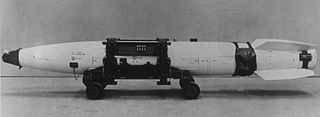1965 Philippine Sea A-4 incident
|
A MK43 free-fall nuclear weapon on a handling dolly | |
| Incident summary | |
|---|---|
| Date | December 5, 1965 |
| Summary | Pre-flight human error |
| Site |
Philippine Sea,[1] 80 mi (130 km) E of Ryukyu Islands[2] (U.S.-occupied Okinawa) 27°33.2′N 131°19.3′E / 27.5533°N 131.3217°E[1]Coordinates: 27°33.2′N 131°19.3′E / 27.5533°N 131.3217°E[1] |
| Fatalities | Pilot (LTJG Douglas M. Webster)[3] |
| Aircraft type | Douglas A-4E Skyhawk |
| Operator |
Carrier Air Wing Five |
| Registration | BuNo 151022[4] |
The 1965 Philippine Sea A-4 crash was a Broken Arrow incident in which a United States Navy Douglas A-4E Skyhawk attack aircraft carrying a nuclear weapon fell into the sea from the aircraft carrier USS Ticonderoga.[5]
The accident
On 5 December 1965, 31 days after Ticonderoga 's departure from U.S. Naval Base Subic Bay in the Philippines,[5] the attack jet fell over the side during a training exercise while being rolled from the number 2 hangar bay to the number 2 elevator.[3] The pilot, Lieutenant (junior grade) Douglas M. Webster; the aircraft, Douglas A-4E BuNo 151022 of Attack Squadron 56; and the B43 nuclear bomb were never recovered[6] from the 16,000 ft (4,900 m) depth.[1] The accident occurred 80 miles (130 km) from Okinawa.[2][7]
Ticonderoga had aboard Carrier Air Wing Five during this cruise, with two squadrons of Skyhawks, the other being VA-144.[8]
Revelation
It was not until 1989 that the Pentagon revealed the loss of the one-megaton bomb.[9] The revelation inspired a diplomatic inquiry from Japan requesting details.[10]
References
- ↑ 1.0 1.1 1.2 1.3 USS Ticonderoga (CVA-14) Deck Log (TRANSCRIPTION IN YOUTUBE CAPTION) (Report). "National Archives"(previously at Washington Navy Yard: Deck Log section). December 5, 1965. Retrieved 2012-04-18. NOTE: The Joe Baugher aircraft listing for this A-4 mistakenly identifies different waters (South China Sea near Vietnam) from those specified by the Deck Log's coordinates (E of Ryukyu Islands).
- ↑ 2.0 2.1 Gibson, James N. Nuclear Weapons of the United States – An Illustrated History. Atglen, Pennsylvania.: Schiffer Publishing, 1996, LCCN 96-67282, ISBN 0-7643-0063-6, p. 130.
Winchester, Jim, Douglas A-4 Skyhawk: Heineman's Hot Rod. Barnsley, Yorkshire, United Kingdom: Pen & Sword Books, 2005, ISBN 1-84415-085-2, page 199. - ↑ 3.0 3.1 "LTJG Douglas M. Webster". A4skyhawk.org. 1965-12-05. Retrieved 2010-03-28.
- ↑ 4.0 4.1 Oskins, James C; Maggelet, Michael H. (2007). Broken Arrow: The Declassified History of U.S. Nuclear Weapons Accidents. Lulu Publishing. p. 217, ch. 29. ISBN 1-4357-0361-8.
- ↑ 5.0 5.1 "Ticonderoga Cruise Reports" (NAVY.MIL WEBLIST OF AUG 2003 COMPILATION FROM CRUISE REPORTS). Retrieved 2012-04-20.
The National Archives hold[s] deck logs for aircraft carriers for the Vietnam Conflict.
- ↑ Broken Arrows at www.atomicarchive.com. Accessed Aug 24, 2007.
- ↑ Winchester, Jim, Douglas A-4 Skyhawk: Heineman's Hot Rod. Barnsley, Yorkshire, United Kingdom: Pen & Sword Books, 2005, ISBN 1-84415-085-2, p. 199.
- ↑ http://www.gonavy.jp/CV-CV14f.html
- ↑ "U.S. Confirms '65 Loss of H-Bomb Near Japanese Islands". The Washington Post. Reuters. May 9, 1989. p. A-27.
- ↑ Washington, D.C.: The Washington Post, "Japan Asks Details On Lost H-Bomb", Wednesday, 10 May 1989, page A-35.
| ||||||||||
